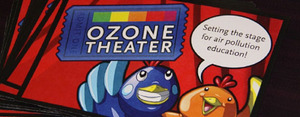By Gina Carroll
Moms Clean Air Force

The folks at Air Alliance Houston believe it’s never too early to teach children about the importance of clean air. With an emphasis on community well-being, it’s no surprise that Air Alliance Houston is heavily influenced by mothers. The organization was founded in 2010 when the only two clean air advocacy groups in Houston decided to become one — GHASP (Galveston-Houston Association for Smog Prevention) and Houston’s Mothers for Clean Air joined forces. And when they merged, Mothers for Clean Air’s most successful program, Ozone Theater became one of the newly created, Air Alliance Houston’s premier community outreach offerings.
In the late 1990’s, Mothers for Clean Air recognized the importance of teaching children about air pollution. In a partnership with University of Texas Medical Branch, they created Ozone Theater. This interactive enrichment program for kindergarten, elementary and middle school classrooms, teaches students about the importance of air quality, and about pollution sources and impact of air pollution. It is offered to any school who requests it, free of charge.
Tifani Pust, Artistic and Educational Programs Director, says that the program served 6,500 students last year. Trained Ozone Theater facilitators are invited to the Health, P.E. and Science classes of Houston area schools and involve students in a curriculum that gets them up from their desks and involved. She says that their approach is very flexible and fluid, so that they can adapt to the subject matter of the class.
“The program has a theatrical emphasis,” says Tifani, “so we engage students in role play and activities that combine the theater arts and lessons about the science behind ozone and the health consequences of pollution.”
The hope is that children will learn about what bad ozone is; what the Air Quality Index means; and what are the health threats of air pollution. Ozone Theater also endeavors to create awareness and empathy for those who are environmentally-sensitive and suffer allergies and asthma. Facilitators also seek to make children increasingly aware of where pollution comes from, so that they can grow up to become advocates for clean air.
Tifani says Houston is a tough nut to crack in terms of air pollution education. There is such a widespread belief among Bayou City residents that cleaning up air pollution will interfere with industry prosperity and job creation. And some of that resistance to addressing pollution has trickled down to the schools. She says that of the 400 schools she has visited since she began three years ago, she only remembers one school whose students knew about the Air Quality Index and what it meant for their health.
How is it possible that so few know what an orange or red day means in a city that had almost an entire month’s worth of bad air days last year? Bad air days, according to the AQI, means that the concentrations of unhealthy ozone exceeded federal air-quality standards (75 parts per billion of ozone). Texas experienced one of its worst air quality years in recent history last year, partly due to drought and wild fires.
But Tifani is hopeful that as more children learn about the causes of pollution and ways to clean the air, awareness will lead to activism and support for responsible emissions in the region. These children, armed with the facts, will be our future informed citizens and clean air stewards.




